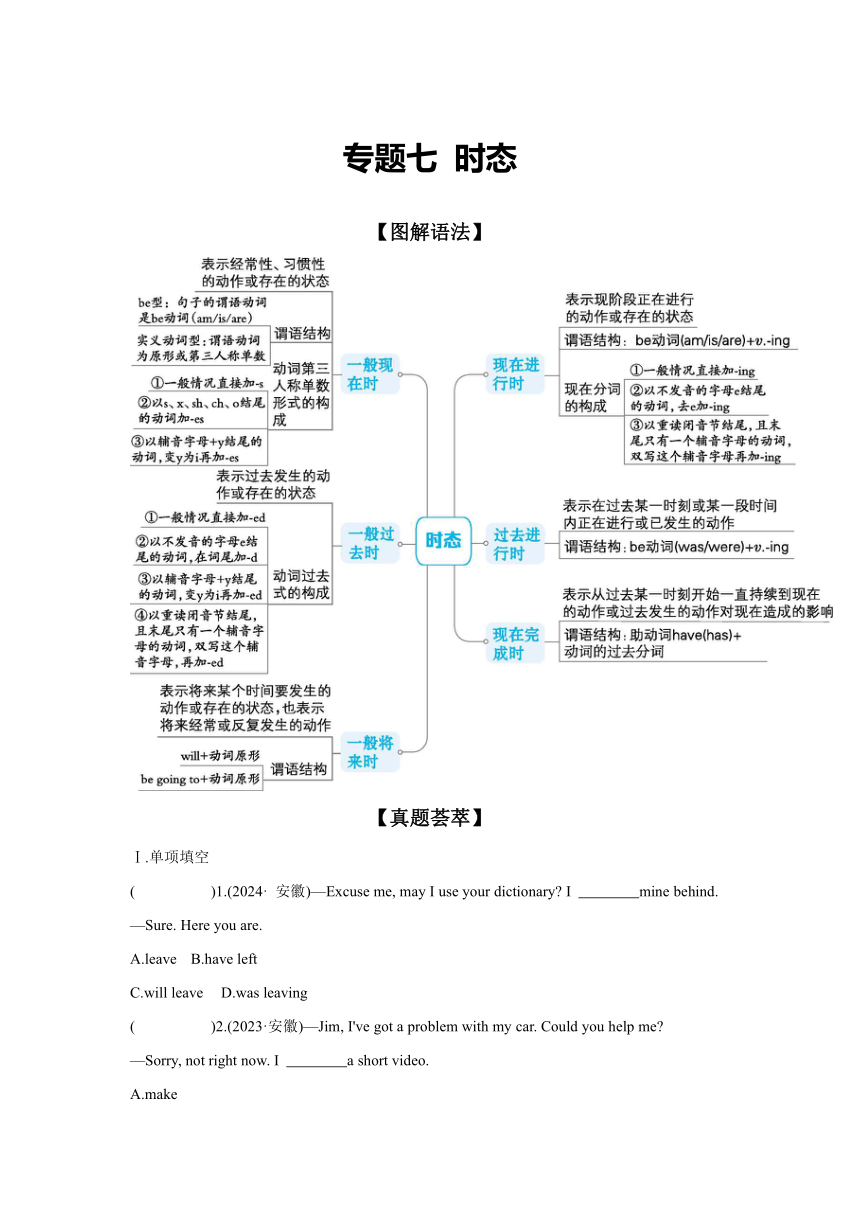
专题七 时态 【图解语法】 【真题荟萃】 Ⅰ.单项填空 ( )1.(2024· 安徽)—Excuse me, may I use your dictionary I mine behind. —Sure. Here you are. A.leave B.have left C.will leave D.was leaving ( )2.(2023·安徽)—Jim, I've got a problem with my car. Could you help me —Sorry, not right now. I a short video. A.make B.have made C.am making D.was making ( )3.(2024·安徽)—What are you saving money for —Father's Day is around the corner. I a gift for my father. A.am going to buy B.have bought C.bought D.was buying ( )4.(2023·安徽)—Our computer is working again! —Yes.Our IT teacher it.It took him about an hour. A.has fixed B.will fix C.is fixing D.was fixing ( )5.(2022·安徽)—The air here is much fresher than before. —Exactly! We a lot of trees in the past few years. A.planted B.were planting C.have planted D.will plant ( )6.(2019·安徽)—It's ten years since we came here. —How time flies! We in China for so long. A.work B.worked C.will work D.have worked Ⅱ.单词拼写 (2024· 安徽)The Shenzhou-17 team h (交) over their work to the Shenzhou-18 team on April 30th. 【知识清单】 三种一般时态的用法 1.一般现在时:主语+动词原形/第三人称单数 标志词:always、often、usually、sometimes等。 用法: (1)表示经常性、习惯性的动作。如: He often watches TV. 他经常看电视。 (2)表示客观真理或事实。如: The teacher said that the sun rises in the east. 老师说太阳是从东边升起的。 (3)表示按照时刻表计划发生的动作。如: The train leaves at 10:00 a.m. 火车上午10点离站。 (4)用于时间状语从句、条件状语从句中,表示将来的动作(“主将从现”)。如: If he comes, I will phone you. 如果他来,我将打电话给你。 2.一般过去时:主语+动词的过去式(-ed) 标志词:just now、 ago、 in 2016、 in the past、 last week、 the other day等。 用法:表示过去某一时间发生的动作或习惯性动作。如: When I was a little boy, I often played games. 当我还是个小男孩的时候,我经常玩游戏。 3.一般将来时:will/be going to/shall+动词原形 标志词:tomorrow、 next week、 in two hours、 in 2060、 in the future等。 用法: (1)shall/will+动词原形,表示动作目前还未发生,而是在将来的某个时间内发生;它没有主观性,是“纯粹的将来动作”。如: I shall/will not be free tomorrow. 我明天没空。 (2)be(am/is/are)+going+不定式,表示说话人的意图、打算或某种可能性。如: He is going to spend his holiday in London. 他打算去伦敦度假。 两种进行时态的用法 1.现在进行时:am/is/are+doing 标志词:now、at the moment、listen、look等。 用法: (1)说话时正在发生的动作。如: They are having a football match. 他们正在进行一场足球比赛。 (2)表示说话人的情感,如赞许、批评、喜欢、厌恶等。如: He is always thinking of others, not himself. 他总是为他人着想,而不为自己(着想)。(表示赞许) (3)表示近期按计划或安排将要发生的动作,用于这种情况的动词很少(如go、come、leave、arrive、return、sleep、stay、wear等)。 We are leaving for London tomorrow. 我们明天动身去伦敦。 2.过去进行时:was/were+doing 标志词:at 8:00 yesterday morning、at that time、then等。 用法:表示在过去某一时刻正在进行的动作。如: At this moment yesterday, I was packing for camp. 昨天这个时候,我 ... ...
~~ 您好,已阅读到文档的结尾了 ~~

